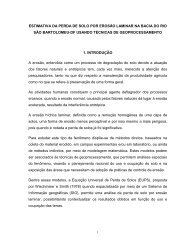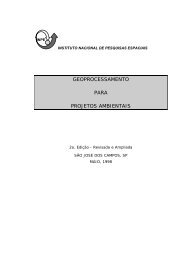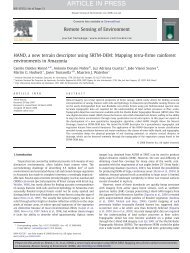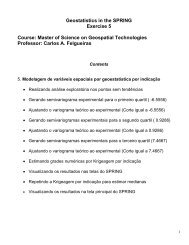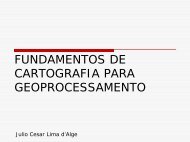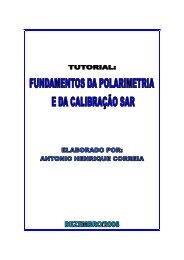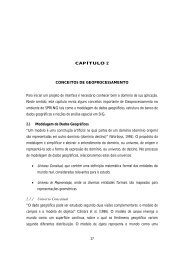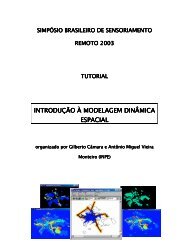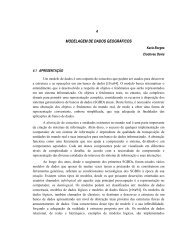- Page 1 and 2:
MINISTÉRIO DA CIÊNCIA E TECNOLOGI
- Page 3 and 4:
vi RESUMO Este trabalho tem como ob
- Page 5 and 6:
SUMÁRIO LISTA DE FIGURAS .........
- Page 7 and 8:
5.2 - A Implementação Maxver ....
- Page 9 and 10: APÊNDICE B - ESTIMAÇÃO DE β PAR
- Page 11 and 12: 22 - Classificação ICM com o uso
- Page 13 and 14: 51 - Matriz de confusão da classif
- Page 15 and 16: 86 - Visualização de uma classifi
- Page 17 and 18: 31 - Distribuições para o caso mo
- Page 19 and 20: 2 a resolu»c~ao espacial azimutal.
- Page 21 and 22: 4 No Cap³tulo 4 e apresentada a mo
- Page 23 and 24: 2.2 - De¯ni»c~oes 6 No decorrer d
- Page 25 and 26: 2.2.5 - A Fun»c~ao de Distribui»c
- Page 27 and 28: 10 b) Para quaisquer constantesa eb
- Page 29 and 30: E(X r ) = 12 Z R xr f(x)dx 1) Coe¯
- Page 31 and 32: 14 oj-esimo momento de Y i, comj·r
- Page 34 and 35: 17 CAPITULO 3 PRINCIPAIS DISTRIBUIC
- Page 36 and 37: 3.4 - Distribui»c~ao Log-Normal 19
- Page 38 and 39: 21 3.7 - Distribui»c~ao Exponencia
- Page 40 and 41: 23 2) O seu momento de ordemr 2 R e
- Page 42 and 43: 25 bn m = cm 2 1 cm 2 ¡ cm 2 1 b¸
- Page 44 and 45: 3.15 - Distribui»c~ao Beta 27 Diz-
- Page 46 and 47: 29 Var(X) = ¡ (2=®+1) ¡(¡ (®¡
- Page 48 and 49: 31 3) Vari^ancia (Frery, 1993; Yana
- Page 50 and 51: 4®nx fX(x;®;¯;n) = ¯¡(®)¡(n)
- Page 52 and 53: 35 ¸; denotada porX » N ¡1=2 (®
- Page 54 and 55: 37 1) Convem observar que, quando°
- Page 56 and 57: CAPITULO 4 MODELAGEM DOS DADOS SAR
- Page 58 and 59: 41 Assim os casos paran visadas pod
- Page 62 and 63: 4.1.1, p. 40), isto e,X I » C(¯):
- Page 64 and 65: Maxver. CAPITULO 5 A CLASSIFICAC»
- Page 66 and 67: 5.2.2 - Associa»c~ao da Distribui
- Page 68 and 69: 51 Paraocaso dasimagensmonoespectra
- Page 70 and 71: CAPITULO 6 CLASSIFICADORES CONTEXTU
- Page 72 and 73: 55 ¯nitos e in¯nitos; sabe-se bas
- Page 74 and 75: 57 O seguinte resultado, cuja valid
- Page 76 and 77: 59 tem-se um modelo repulsivo; quan
- Page 78 and 79: 61 suponha-se que ¥ s e um subconj
- Page 80 and 81: 63 ² k 4 denota o contador das con
- Page 82 and 83: 65 Desenvolvendo a Equa»c~ao 6.3,
- Page 84 and 85: k0422 Ä Ä N ¥ | N ¥ N N k032111
- Page 86 and 87: 69 Para detalhes de implementa»c~a
- Page 88 and 89: 71 Figure 2: - Janela exemplo para
- Page 90 and 91: 73 em uso. O terceiro metodo, com u
- Page 92 and 93: w à y ¯ à Estima Beta ( y) y Ã
- Page 94 and 95: CAPITULO 7 O TESTE DA CLASSIFICAC»
- Page 96 and 97: 7.2 - Os Testes de Hipoteses para C
- Page 98: 81 2:257, o mesmo pertence µa regi
- Page 101 and 102: 84 b) Imagem com resolu»c~ao espac
- Page 103 and 104: 86 Figure 7: - Imagem JERS-1 de Tap
- Page 105 and 106: 88 Figure 9: - Imagem TM classi¯ca
- Page 107 and 108: 90 8.1.2 - Estima»c~ao do Numero E
- Page 109 and 110: 92 mas de converg^encia na estima»
- Page 111 and 112:
94 Figure 12: - Autocorrela»c~ao v
- Page 113 and 114:
96 Figure 16: - Ajuste da distribui
- Page 115 and 116:
98 duas classi¯ca»c~oes. Sob a hi
- Page 117 and 118:
100 Figure 19: - Classi¯ca»c~ao M
- Page 119 and 120:
102 TABELA 16 - EXATID ~ AO DA CLAS
- Page 121 and 122:
104 Figure 25: - Matriz de confus~a
- Page 123 and 124:
8.1.7 - Conclus~oes 106 para a imag
- Page 125 and 126:
108 numero de visadas, a imagem ori
- Page 127 and 128:
110 do modelo multiplicativo, foi a
- Page 129 and 130:
112 TABELA 21 - AJUSTES DO SOLO NA
- Page 131 and 132:
114 Figure 29: - Ajuste da GA0 para
- Page 133 and 134:
116 observados na Figura 32, p. 117
- Page 135 and 136:
118 Figure 34: - Fun»c~oes densida
- Page 137 and 138:
120 classes foi obtida a classi¯ca
- Page 139 and 140:
122 Figure 38: - Classi¯ca»c~ao I
- Page 141 and 142:
124 Figure 40: - Classi¯ca»c~ao M
- Page 143 and 144:
126 Figure 42: - Classi¯ca»c~ao I
- Page 145 and 146:
128 2) Imagem degradada: Os valores
- Page 147 and 148:
130 3) Dos resultados obtidos com o
- Page 149 and 150:
132 Figure 43: -Matriz de confus~ao
- Page 151 and 152:
134 Figure 47: - Matriz de confus~a
- Page 153 and 154:
136 Figure 51: - Matriz de confus~a
- Page 155 and 156:
138 Figure 55: -Matriz de confus~ao
- Page 158 and 159:
141 CAPITULO 9 CONCLUS ~ OES E SUGE
- Page 160 and 161:
143 ² Pode-se a¯rmar que a aplica
- Page 162 and 163:
145 REFER ^ ENCIAS BIBLIOGR AFICAS
- Page 164 and 165:
147 Erthal, G.J.; Frery, A.C. Segme
- Page 166 and 167:
149 Kelly, P.A.; Derin, H.; Hartt,
- Page 168 and 169:
151 Yanasse, C.C.F;Frery, A.C.; San
- Page 170 and 171:
153 AP^ENDICE A ESTIMAC» ~ AO DE¯
- Page 172 and 173:
155 AP^ENDICE B ESTIMAC» ~ AO DE¯
- Page 174 and 175:
+k 1322ln 157 Ã e +k14111ln ¯ e4
- Page 176 and 177:
159 B.2 - Equa»c~ao para estima»c
- Page 178 and 179:
¡e 2¯ +K ¡7 161 +k1211111 e2¯ +
- Page 180 and 181:
163 AP^ENDICE C ESTIMAC» ~ AO DE¯
- Page 182 and 183:
165 TABELA 30 - Conclus~ao k081111
- Page 184 and 185:
+k 543ln +k 552ln à +k54111ln +k 5
- Page 186 and 187:
+k 3522ln à +k 351111ln +k3432ln +
- Page 188 and 189:
+k24311ln +k242211ln à à +k 24111
- Page 190 and 191:
173 Ã e +k153111ln ¯ e5¯ +e3¯ +
- Page 192 and 193:
175 ¡k081111ln ³ e 8¯ +4e ¯ +K
- Page 194 and 195:
177 ¡k 03321111ln ³ 2e 3¯ +e 2¯
- Page 196 and 197:
e 5¯ +5e ¯ +6K ¡18 179 +k651 e6
- Page 198 and 199:
¡5e 8¯ +2e ¯ +3K ¡9 181 +k381 e
- Page 200 and 201:
¡2e 4¯ +K ¡4 183 +2k2442 2e4¯ +
- Page 202 and 203:
¡4e 5¯ ¡2e 3¯ +K ¡6 185 +k1531
- Page 204 and 205:
¡k 0741 ¡k07311 ¡k 072111 187 7e
- Page 206 and 207:
¡k 033222 ¡k 03321111 ¡k 0322221
- Page 208 and 209:
191 AP^ENDICE D ESTRUTURA DO SISTEM
- Page 210 and 211:
193 de arquivos (*.i, *.mxv, *.tif,
- Page 212 and 213:
195 Se a imagem for aberta a mesma
- Page 214 and 215:
D.2.3 - \Close" vas. 197 Esta op»c
- Page 216 and 217:
199 Na atualidade apenas o modulo p
- Page 218 and 219:
201 ² \List of samples": lista das
- Page 220 and 221:
203 Figure 69: - Interface para sel
- Page 222 and 223:
205 opera»c~ao a imagem sera gerad
- Page 224 and 225:
207 As opera»c~oes aplicadas na im
- Page 226 and 227:
? \N Intensities" 209 ? \Pair Ampli
- Page 228 and 229:
211 \Multispectral Univariate Phase
- Page 230 and 231:
213 Figure 73: - Interface para eli
- Page 232 and 233:
215 ± \Add": bot~ao que ativa a GU
- Page 234 and 235:
217 ± \Samples List": lista para s
- Page 236 and 237:
² \Chi-square goodness-of-¯t test
- Page 238 and 239:
221 Figure 82: - Interface com o re
- Page 240 and 241:
D.5.2 - \Utilities - Statistics" 22
- Page 242 and 243:
D.5.4 - \Utilities - Annotate" 225
- Page 244 and 245:
D.5.6 - \Utilities - Color Tables"
- Page 246 and 247:
229 2 Distribui»c~ao Normal.......
- Page 248 and 249:
231 2.5.1 O Numero Equivalente de V
- Page 250:
233 2.7 Teste de Igualdade dos Coe



